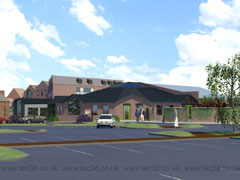A Solar Chimney can assist natural ventilation
A solar chimney, or a solar thermal chimney, can be used to improve natural ventilation in buildings by encouraging the convection of air upwards.
A simple vertical shaft designed to absorb solar heat will cause hot air to rise out of the top of a building - and draw cooler air into the base of the building to generate natural stack ventilation. A solar chimney can assist natural ventilation, particularly in regions with high solar irradiation and low wind speeds. Heat recovery can be used in the chimney to collect energy for heating domestic hot water, or stored in a Thermalbank for use in a cold season.
Solar chimneys have been in use since the time of the Persians and the Romans.
Passive Downdraught Evaporative Cooling
Passive downdraught evaporative cooling can also be used in hot dry climates to improve the natural ventilation of buildings by encouraging the convection of air downwards. Small droplets of pressurised water can be sprayed into the incoming ambient air at the top of a cooling tower. As the water evaporates into the air stream it absorbs heat and cools the air. The air becomes denser as it becomes cooler and falls to the base of the tower and enters the building.
It is possible to use an evaporative tower and a solar chimney at opposite sides of the same building to work in conjunction with each other to provide natural ventilation by encouraging cool air to enter at low level and hot air to be drawn out at high level.
Passive Cooling
Ideally, passive cooling of buildings is achieved by careful design without the need for mechanical intervention. One advantage is the avoidance of running costs.
Careful design can also be used to enhance Natural Cooling. The advantage is much lower running costs than using standard air conditioning.
See Ground Source Heating See Ground Source Cooling See Ground Source Energy

